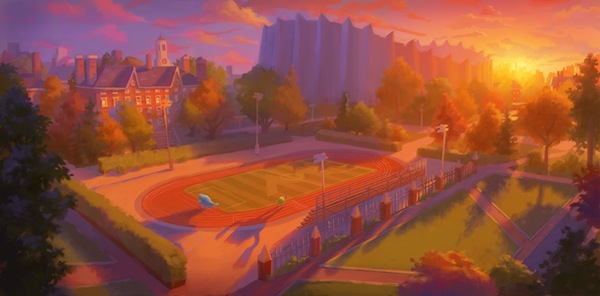Be honest: are you afraid of prequels? If so, you’re not alone.
The Star Wars prequels were an all-time low for many movie-goers, leaving a whole generation of Jedi-aficianados with psychological scars. The first of the Hobbit films, though not as bad a misstep, certainly lacked the power of its awe-inspiring predecessors. Prequels in general (which are just a special case of the much-feared sequel) have left many a bitter taste over the years, and you’d be justified to have developed a full-fledged case of prequel-phobia.
So it struck me as interesting when Pixar announced they were making a prequel to Monsters Inc., one of their best films. Despite Pixar’s stellar box office record, the recent critical flop of Cars 2 had shaken the faith of those who believed the studio could do no wrong. On the other hand, if anyone could do a prequel right, it would be the folks who single-handedly brought Disney back from the brink… and Monsters would get treated with more finesse than Cars, right?
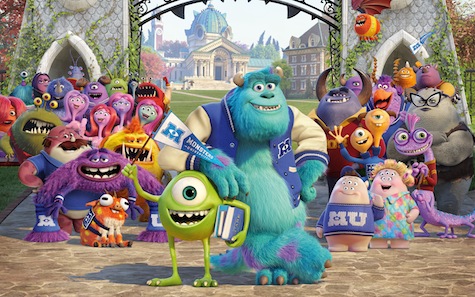
It was thus with bated breath that I took my two-month old to see Monsters University this summer. Within minutes, my fears were allayed: she slept the entire time. But more than that, I realized Pixar had nailed it once again. This was one of the best movies they’d yet made, even rivaling the original, and in the afterglow, I not only questioned my long-standing fear of prequels, I also decided to figure out what it was Pixar had done so right.
Disclaimer: I used to work at Pixar, and have credits on several of their films and shorts. That said, I try to remain unbiased about Pixar movies—if anything, my knowledge of the company’s inner workings makes me be a better critic, since I know first-hand how awesome Pixar can be at its very best. Still, you’ll have to take my word for it that nobody asked me to review this film.
A “story world” is my way of referring to unique worlds crafted for particular stories. The term can refer to a fantasy realm like in Game of Thrones; a sci-fi future such as the world of The Matrix; a slice of Earth’s past as in Downton Abbey; or even a world of make-believe, as is the case with Monsters Inc.
In a two-part article about JRR Tolkien, I laid out six principles that make for a great story world (world-building, characters, plot, theme, craft, and originality), and proposed that Tolkien nailed all six of these. So what about a smaller and less bombastic story such as Monsters University? Has Pixar created another classic? If so, does it meet all six criteria? And how did they manage to escape the usual pitfalls of a prequel/sequel—namely, that reusing existing worlds and characters tends to make a story feel stale?
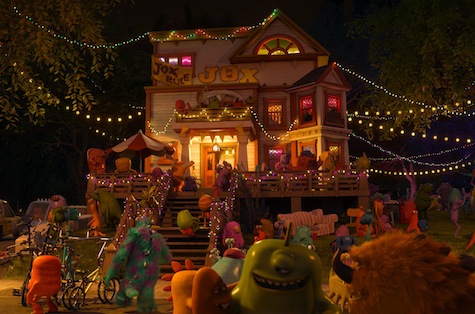
Let’s start with world-building. One of the common problems with prequels/sequels is that we often find ourselves back in the same old place again. Same old pirate ship. Same old police academy. As interesting as the world was the first time around, we’ve been there and done that.
Monsters University, however, expands on the world of Monstropolis in a big way. In the first movie, we were mostly confined to a Scare Factory. In the new movie, we’re at a massive college campus, complete with fraternities and lecture halls and dorms and more. It’s not just a bigger world, it’s a whole different world using familiar elements (e.g. doorway portals, scream canisters, and monsters), but presenting a much bigger and more colorful environment.
Watching the movie, I was wide-eyed at all the clever gags and jokes that came from sending monsters off to college. But the new setting is not just about clever humor—because a great story and the world it inhabits need to fit together like a glove. If the prequel to Monsters Inc. had been set at the factory again, no matter how interesting the story was, at some level we’d be watching the same movie. That factory was quite literally created for the story of Monsters Inc. Instead, Pixar sets the new movie in a whole new world, and it therefore takes a whole different kind of story to make the world come alive.
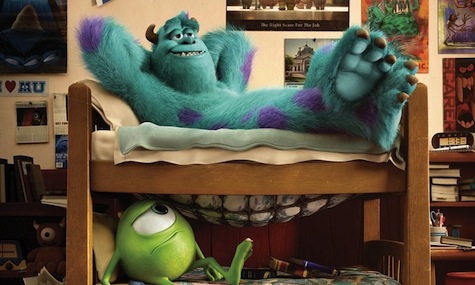
Another problem with sequels has to do with characters. Characters (especially in movies) tend to have a big flaw that gets solved over the course of a film, and they don’t usually have a second big flaw hanging around for a sequel. By the end of Monsters Inc., Mike and Sulley have repaired their friendship, cleared their names, and learned to love children. Where do you go from there? You’d have to invent a new problem for them, and this is where sequels (true sequels, not planned trilogies) often start to feel contrived.
The Pixar solution: go back in time. At the beginning of Monsters University, Sulley is a whole different beast than the big cuddly guy who later falls in love with Boo. He’s arrogant, lazy, and condescending—Pixar actually took quite a risk making their lovable monster unlikable. Mike, too, is different from his older self: he’s wide-eyed, optimistic, intent on becoming a Scarer, not yet as sardonic as the grown-up he later becomes. In terms of their story arcs, the younger Mike and Sulley are actually different characters (facing different challenges) than they are in Monsters Inc.
So once again, this means it takes a different kind of story—one involving frat parties and secret initiations and daredevil stunts—to solve their character flaws. Mike has to go through the wringer and learn he’s meant to be a coach. Sulley has to get over his ego and become a part of a team. New characters, new world, new story. That’s how to properly make a sequel.
Which takes care of the first two pillars: world-building and characters. We can put check marks by two more: plot and craft. The plot of Monsters University is tight and well-paced; it’s easy to enjoy the college hijinks that make up the bulk of the film. (The folks at Pixar are very good at this, in part because of the intricate storyboarding that takes place before a film goes into production.) Similarly, there’s no question about craft when it comes to a Pixar movie; the studio knows how to tell a good story and make it look stunning on screen.

So what about theme? Pixar movies tend to play broad and heartfelt, built on themes like friendship, family, bravery, and relevance—themes which speak to adults yet appeal to kids. Monsters U continues in that tradition: it’s about the friendship between Mike and Sulley, the teamwork of Oozma Kappa, the value of being dedicated to a goal, and so on. These family-friendly themes may not have the soul-searing depth of the films that go down as the all-time greats, but they do make for a movie that kids and parents will treasure for decades.
Which leaves the pillar of originality. And here, there’s just no avoiding the fact that Monsters University is part of a set. But Pixar earns highest marks for making this movie as fresh and original as possible, given that the world and the characters already exist in the mind of the audience. Monsters U could easily have been the first entry in the franchise; in fact I’ll wager that many kids will be getting their first exposure to Mike and Sulley via the prequel. That’s a sure sign that the prequel stands on its own.
Here’s what it all adds up to: Monsters University is a very good movie. It’s not a powerful movie that will echo for generations, and you can’t exactly call it ground-breaking—but as far as the specific act of telling a brand new story using existing worlds, characters, and ideas, this movie is as an easy A.
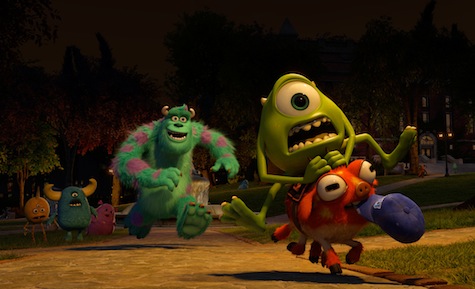
All of which raises a key question: will Finding Dory (the sequel to Finding Nemo) sink or float when it hits theaters in 2015? Given the vast array of fish-filled worlds lurking beneath the ocean, I’m going to guess the movie will be a huge hit. If Pixar has shown anything over the years, it’s that they know how to dig deep into the creative well and surprise both fans and critics.
As someone who is equal measures of both, I tip my safety helmet to those magic-makers in Emeryville for purging me of my prequel-phobia. Scary good work, folks.
Brad Kane is a writer in the entertainment industry, focusing on storytelling in movies, TV, games, and more. If you enjoyed this article, take a second to like his page on Facebook and/or to check out his blog. He also has a new Twitter account that he is trying to remember to use.










